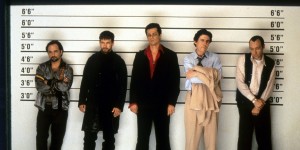The Usual Suspects veers between the Classicist and Formalist modes. I would argue that it for the most part classicist: the focus of the film is on the complex story that Verbal spins for Kajun under interrogation. It is vital for the success and cohesion of the film that emphasis is placed on narrative over form (although form is an important aspect of the film). It is a non-linear narrative told in flashback form – a tale that we are not entirely sure whether or not to believe. It is therefore essential that the Bryan Singer made the film more classicist than wholly based on the formalist mode. If there is one thing that most people remember about The Usual Suspects it will be the twist at the end – the cathartic moment in which Kajun drops his coffee as he realises the true identity of Verbal.
However, the cinematography of the film is obviously stylised formalistically. For example: the way in which the camera lingers over the debris at the dock in the first scene where Verbal is revealed to be hiding/not hiding. The director places the image of the debris into the subconscious of the audience despite it not having any relevance until the end of the film. Similarly, the way in which light is used to illuminate the faces of the actors throughout the film – particularly when they are confronted with the figure of Keyser Soze. This use of lighting is entirely unrealistic but acts as a visual indicator of realisation or surprise.
